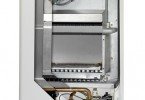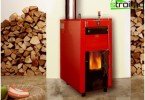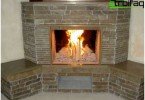Pipes for heating
What requirements did people make at all times to their home? Of course, warmth and comfort are the main aspects of this issue. It is pointless to argue with this opinion, because no arguments can prove the opposite. High performance of these characteristics can provide an efficient heating system. Yes, it’s effective, why waste money on low-quality devices, equipment and materials. We live in a new century, and he dictates his own rules and laws, and man must comply with them. For the full functioning of the coolant pipes for heating are needed: which are better to choose if today the assortment is diverse and multifaceted? Let’s try to figure it out.
Content
- Basic requirements for heating pipes
- What affects the choice of pipes
- Dependence on the heating system
- Calculation of pipe diameter
Basic requirements for heating pipes
Undoubtedly, pipes play an important role in an integral heating system. We can say that their function is extremely responsible, because it is the pipes that deliver hot water from the boiler (regardless of its type) to radiators. Based on this argument, it is possible to determine the primary requirements for pipes: they must be durable and maintain this characteristic throughout the entire life cycle. And for a long service life, the pipes should not let oxygen through, as this contributes to the rusting of the system from the inside, as well as the pipes become clogged and “overgrown”. As a result, the overall system performance is reduced..
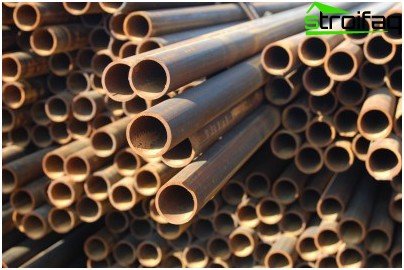
Black metal is rarely used for heating circuits; it rusts quickly, needs maintenance
Maintaining an optimal temperature regime depends on the tightness of the system, and also a person must be sure of the reliability of the pipes, that the coolant will not go beyond the boundaries of the pipe and will not spoil the materials and equipment that are nearby. Strength characteristics are largely determined by the material from which this or that pipe is made. The modern market offers many options, but you need to soberly assess the situation and think through every detail so as not to be in a force majeure situation, especially in the winter. After all, failures in the heating system in the cold season are unnecessary and undesirable.
Low noise is a factor no less significant. The calm and comfortable atmosphere in the house will be disturbed by the constant flow of flowing water. And yet, no one canceled the beautiful aesthetic appearance of the pipes. It is not always possible to hide the wiring in the walls, for example, if the house is wooden. But in other cases, in some places the pipes still come to the surface and are connected to radiators.
The pipes of the heating circuit must necessarily meet the above requirements in each specific case, since the choice of pipes depends on some other indicators, and we will talk about them now.
What affects the choice of pipes
When choosing pipes for heating, you need to pay attention to such points:
- gasket type – external or hidden;
- average heat carrier temperature and pressure in the heating system;
- installation – a complex or simple system configuration;
- the location of the pipeline – in the case when part of the pipeline will pass through a room that is not heated, then it is necessary to think over the options for insulation;
- the possibility of carrying out, if necessary, repair of pipes and, most importantly, good access to them.
The thing is that the pipes are made of different materials, which means that they have laying features for installation, assembly of the system and operational characteristics.
Dependence on the heating system
Probably everyone knows that there are two of the most basic heating systems: centralized and individual. Naturally, the pipes must correspond to a specific system, for example, in private houses and cottages a system is equipped on an individual basis: the pressure in the pipes in this case does not exceed 2-3 atmospheres.
And in the central heating system, which is used in urban high-rise buildings, a pressure of 16 atmospheres is possible. Basically, such high rates are achieved during the start-up of the system for cleaning the pipeline from traffic jams..
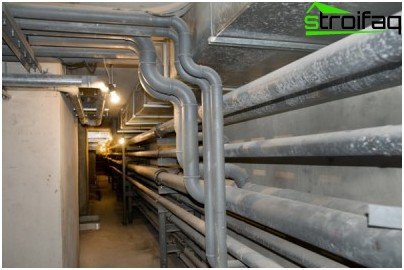
Pipes for central heating
Now we should consider in detail the possibility of using different types of pipes in these heating systems. Basically, four types of pipes are used:
- reinforced – suitable for both heating systems, as they are designed for a pressure of 25 atmospheres;
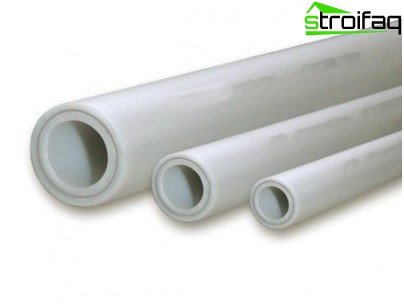
Universal reinforced pipes are distinguished by their strength and ability to withstand critical pressures of seasonal crimping
- polypropylene pipes are best used for an individual system, since they are designed only for 6-10 atmospheres;
- metal-plastic pipes are used both in the individual and in the central system. They are durable and corrosion resistant;
- Steel piping is more common in central heating systems. But if a welding joint is used, and not a thread, then the pipes are more susceptible to corrosion and the protective layer of the pipe is destroyed.
If we talk about a system with natural circulation and a floor boiler, it is difficult to do without metal pipes. The price / diameter ratio in this case will be optimal, because the cost of a 1.5-inch copper or metal-plastic pipe and similar of “black” steel differs significantly.
In fact, in a water supply system, a “black” metal pipe quickly rusts, but this does not apply to a central heating system. Water, i.e. coolant, circulates in such a pipeline for a long time, oxygen evaporates quickly, and a system made of steel pipes lasts up to 50 years.
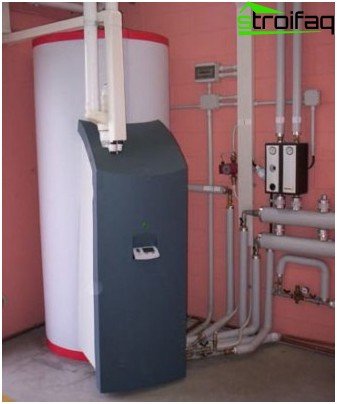
For the device of the autonomous heating system, mainly metal-plastic and plastic pipes are chosen
When using a wall-mounted boiler with a copper heat exchanger in combination with forced circulation, that is, a pump, steel pipes will only interfere. Firstly, a system built from such pipes does not look very aesthetically pleasing, and even at the initial corrosion stage, a thin heat exchanger may become clogged. In addition, the cost of installing “black” pipes is not too different from the cost of equipping a plastic and copper system.
Modern heating systems are different from the previous ones, so steel pipelines, so to speak, are not in fashion today. It is often advantageous to use a steel pipeline when mechanical strength and large diameters are needed.
Important: they are also suitable for replacing black pipes, but it is advisable to stop the choice on the galvanized version.
Calculation of pipe diameter
To create a complete heating system, you need to familiarize yourself with the theory, in particular with the principle of calculating the required pipe diameter. When piping, this parameter is very important, the correct calculation helps to avoid unnecessary heat loss and wasted energy.
The diameter of the pipe is the size that determines its dimensions; You can carry out an independent calculation, for this you need to know some parameters: the inner diameter of the fittings, fitting, as well as the nominal indicator of the inner diameter and wall thickness. For example, an increase in diameter, which is used to increase the area of heat transfer, will inevitably lead to a drop in pressure and heat loss.
Calculation of the diameter is carried out according to various formulas and schemes, traditionally a peculiar inch system is used for measurement. The calculation of the diameter depends on many factors: pressure in the distributing pipe, composition and quality of the coolant. It’s hard to remember all the formulas, so it’s better to go the easy way and use the calculation table, everything is clearly and clearly indicated, and the parameters of the coolant, and the pipe wiring diagram, and the characteristics of the heating devices.
It can be concluded correctly that it is not worth ignoring the calculation, since each specific system is tied to the devices used, and also uses a specific heat carrier (water, antifreeze, artificial heat carrier), and also takes into account the circulation method in the heating system.
Types of pipes for heating: which is better?
Heating system of steel pipes and cast iron radiators lost its advanced position and handed the palm to other materials and technologies. This is not surprising, because life and science do not stand still, they are constantly moving forward. So which pipes to choose for heating your monastery, so that there is quality, and an affordable price, and saving the family budget? Now we will deal with this issue.
Metal-plastic – a universal solution
This is an effective combination of the properties of plastic and metal pipes. Such excellent harmony is possible due to the specific design: the pipe consists of a base of aluminum alloy, which is coated with high density polyethylene. In this case, the outer layer is characterized by increased resistance to aggressive environment.
Typically, plastic pipes are widely used as a hot water supply, as well as in floor and radiator systems. Their main distinguishing feature is a small coefficient of thermal expansion, this indicator allows you to significantly increase the distance between the supports during installation and, if used, you can do without compensators.
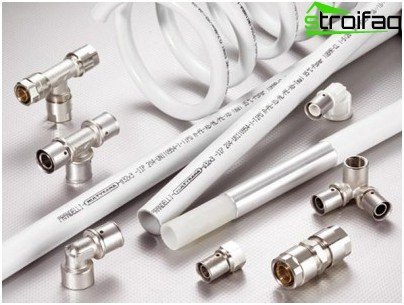
Plastic pipes – a decent option
The design of a metal-plastic pipe has several advantages:
– 100% gas impermeability;
– high throughput;
– excellent tear resistance;
– aesthetic appearance that fits easily into the interior of the room;
– long service life;
– low cost of installation work;
– the possibility of weldless connection;
– great flexibility;
– do not corrode.
But there are some disadvantages:
– under the influence of ultraviolet radiation, metal-plastic pipes are destroyed.
Important: to stop this process, it is necessary to put on special protection in places of this very impact, that is, a corrugated pipe.
– restriction in the choice of diameters.
This type of pipe is connected using threaded or crimp fittings, by gluing.
Copper pipes – a long tradition
Copper is a pipe material that has been actively used from the end of the 17th century until today. This trend is not an accident, because it is a good option for autonomous heating.
For the manufacture of such pipes, only high-quality copper is used, almost without impurities, so the copper pipe is characterized by strength and high corrosion resistance. Sometimes the surface of the pipes is covered with a polyvinyl chloride or polyethylene layer. This measure has a positive effect on reducing heat loss when hot water passes through pipes, and condensation does not appear when cold water is supplied and the appearance improves. Copper pipes are hard and soft.
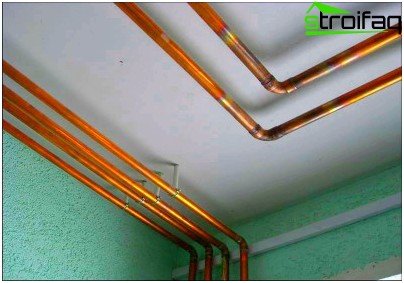
Copper pipes have an extensive list of advantages and the only drawback is the price.
Copper pipes have the following advantages:
– good thermal conductivity;
– corrosion resistance;
– bactericidal effect;
– excellent range of working temperature: -200 – + 200 degrees;
– with pressure surges and system freezing, they are resistant to rupture;
– high throughput, because the inner surface is very smooth;
– impermeability to oxygen;
– long service life (about 100 years);
– aesthetic look.
Well, the only negative against the background of significant advantages is the high cost.
Steel is the best option for the budget
Until recently, steel pipes rested on the laurels of the championship, but the olden days have already passed, today they have much less popularity. It’s just that there was no alternative before, but now it is available.
In terms of mechanical strength and a small percentage of expansion, steel pipes do not have worthy rivals in heat supply and steam heating. High thermal conductivity is the main criterion for creating a radiant form of water heating.
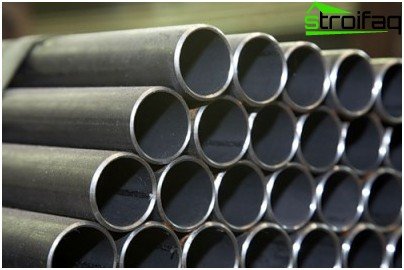
Steel pipes are recommended to be galvanized before installation.
But there are drawbacks, and they are significant: steel pipes are subject to corrosion, galvanizing techniques can be used to protect them. This option is most ideal for domestic use. Still these pipes are heavy and inconvenient to use due to their overall dimensions. And installation involves the use of gas welding. But if for a person the main aspect of choice is price policy, then such a solution is optimal.
Stainless steel – a wide range of applications
Such pipes are made of alloy steel and are worthy of general attention. With proper operation, stainless steel pipes more than pay back the initial costs. Their main advantages are corrosion resistance and strength. These are not “black” pipes that are oxidized and clogged with rust; these pipes, although expensive, are economically viable. When using them, you won’t have to buy and change fittings, valves, faucets and the like again, scolding unscrupulous manufacturers.
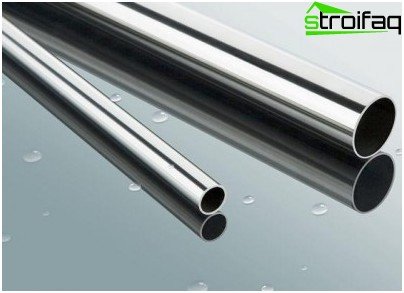
Corrosion-proof pipes – a symbiosis of strength, reliability, aesthetics and long-term
In addition, the range of application of stainless pipes is impressive: “warm floors and walls”, boiler piping and many other areas. Savings on the face, it’s better to spend money, and then enjoy the benefits received.
Plastic pipes – new technologies
Such pipes must be selected carefully and with great responsibility, since the reliability and durability of the heating system depends on their quality.
Plastic pipes are manufactured using modern equipment, and new scientific achievements are used in the production process. As a result, the output is products that meet building codes and standards. Such pipes are not only reliable, but also cheap to install. For him, no expensive equipment is needed, and further preventive work does not require large financial investments. It is worth noting that plastic pipes retain their performance throughout the service, and they are not exposed to negative chemical and physical manifestations.
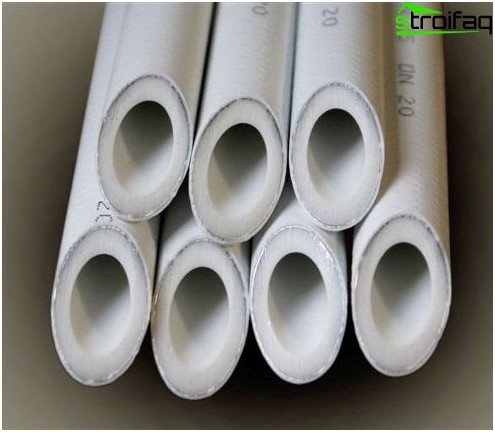
Polypropylene plastic pipes – reliability plus easy quick installation
The heating system, which is based on the use of such pipes, can be easily and beautifully sealed with finishing materials, so there are pluses in this regard. With the help of plastic pipes, it is possible to implement complex projects without any problems, because their service life is more than 20 years.
For heating, all the pipes mentioned above are suitable, just when choosing, you need to think rationally and keep up with reality.


